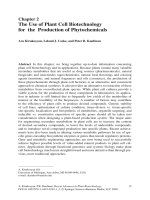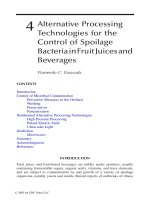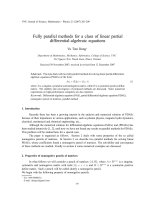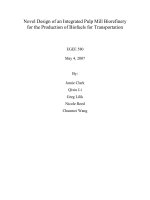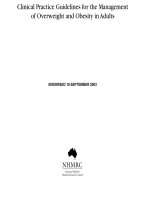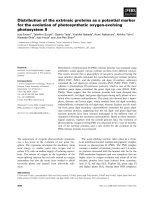Cocoa Processing Methods for the Production of High Quality Cocoa in Vietnam ppt
Bạn đang xem bản rút gọn của tài liệu. Xem và tải ngay bản đầy đủ của tài liệu tại đây (1.39 MB, 18 trang )
Cocoa Processing Methods for the Production
of High Quality Cocoa in Vietnam
1
2
Table of Contents
Acknowledgements
List of figures
List of Illustrations
List of plans
Harvesting of pods
Storage of pods
Breaking of pods
Fermentation of cocoa
Basket fermentations
Heap Fermentations
Box fermentations
Effect of pod storage
The effect of spreading beans after pod breaking
Soaking of beans after fermentation
Summary of fermentation procedures
Drying of cocoa
Quality standards
Construction of solar driers and fermentation boxes
Plans for solar driers
Plans for fermentation boxes.
List of figures
Figure Page
1: Temperatures of cocoa in a 50kg basket fermentation
2: Temperatures of cocoa in heap fermentations
3: Temperatures of fermentations in box capacities of 250kg, 100kg, 50kg and 25kg
4: The effect of pod storage on the fermentation temperatures of cocoa.
5: The effect of pod storage and fermentation time on the percentage of fully brown beans in the cut test.
6: The effect of spreading of beans for two hours, prior to placement in boxes, on fermentation temperatures.
7: The effect of spreading of beans for two hours, prior to placement in fermentation boxes, on cut test results
8: The effect of soaking of beans in water, for two hours, prior to drying, on brown bean percentages.
List of Illustrations
Illustration Page
1: Storage of pods in a bamboo cage
2: Pod storage on the floor of a home
3: Cane basket fermentations
4: Plastic basket fermentations
5: Heap fermentation at Nong Lam University. Placing of beans on a banana leaf layer
6: Heap fermentation. Covering of beans with banana leaves.
7: Covering of heap with Hessian bags to keep the heat in
8: Turning of beans by hand
9: Cocoa fermentation boxes in Ben Tre Provence
10: lining of bottom and sides of box with banana leaves
11: Turning of beans by hand in a 50kg fermentation box
12: Partitioned boxes for fermentation of quantities above 100kg wet beans.
13: Drainage holes, for excess moisture, in bottom of boxes.
14: Cocoa beans spread on wire mesh, for two hours, prior to placement in fermentation boxes
15: Placental material should be removed when breaking pods and during fermentation.
16: Cocoa with good brown coloration after fermentation
17: Over-fermented cocoa showing blackish and mould infected cocoa beans
18: Wet beans cut during a fermentation
19: Sun drying of cocoa on mats in Dak Lak Province
20: Traditional sun drying of cocoa in Ben Tre Province
21: A second traditional sun drying method in Ben Tre Province
22: A solar drier recommended for the Mekong Delta region of Vietnam with cocoa on the drying bed
23: Cocoa dried by the traditional sun drying methods (7 & 8 days) compared to cocoa dried on a
solar drier (5 & 6 days)
24: Cut test chart for determining cocoa bean quality
ACKNOWLEDGEMENTS
The author wishes to thank AusAID and the Vietnam Ministry of Agriculture and Rural Development for
approving the project and AusAID’s funding.
Thanks also to the staff of Can Tho University, Nong Lam University and Western Highlands Agricultural
Science Institute who contributed their time and labour to the project activities.
Department of Science and Technology (DOST) in Ben Tre Province is thanked for their assistance in farmer
surveys and the selection of smallholder sites for solar drier evaluation.
Smilja Lambert of Mars, Inc. is thanked for her assistance with project activities, her technical advice and
liaison with the Vietnamese research Institutes involved.
Success Alliance is also thanked for their assistance in providing information regarding the cocoa industry in
Vietnam and in the establishment of solar driers and fermenting boxes at their demonstration farm sites in Ben
Tre Province
HARVESTING OF PODS
After planting of seedlings, cocoa trees usually take about two years before ripe pods start to be produced.
During harvesting, only ripe pods should be picked as beans from unripe pods will not ferment properly. Pods
which are damaged or have fungal infections should be discarded and not included in the harvest. It is best to
harvest cocoa regularly so that pods do not get over-ripe.
Over-ripe pods are more likely to get fungal diseases which affect the beans which should then not be used.
Pods that have fungal diseases should be picked from the trees and placed on the ground away from the
cocoa trees or can be buried. This will help stop infection of other pods. Mice and rats will also eat ripe pods. If
pods are left too long on trees, the beans will start to germinate and this is undesirable for the general quality
and flavour of the cocoa after fermenting and drying.
Pods should be harvested every week during the harvest periods and every two weeks when there are not too
many pods. When pods are cut from the tree, they should be cut with a sharp implement. This is to make sure
the pod stem is cut off cleanly, without damage to the flower cushion. This is the point where the flower grows
and then forms a pod. Damage to the flower cushion will mean flowers and pods will not grow on it again. A
different cutting implement should be used to remove diseased pods from the tree. If the same knife is used, it
will help the disease to spread.
STORAGE OF PODS
After harvesting, pods should be subjected to storage as in illustrations one or two.
3
Illustration 1: Storage of pods in a bamboo cage Illustration 2: Pod storage on the floor of a home
It is best to store pods in a cool and dry position, under cover from rain, as this will tend to reduce the
possibility of fungal contamination. Pods, which become infected with fungi, should be discarded. Pods are
generally stored for seven to nine days or longer. When pods are ready to ferment, you will be able to hear
and feel the beans moving inside when the pods are shaken. This means that enough moisture has been lost
from the pod to allow a good fermentation.
BREAKING OF PODS
Pods should be broken with a blunt object such as a piece of wood to avoid damaging the beans. It’s best to
avoid using a knife to cut pods, as beans may also be cut by the knife and this will affect their quality after
fermenting and drying. Pods should not be broken in the rain, as this will wash away the pulp surrounding the
beans and this will affect the fermentation. Beans which are black or have shoots on them or flat beans, which
have not grown properly, should be discarded.
After breaking of the pods, the beans can be spread out in the sun, on a concrete or plastic sheet surface for
approximately two hours (Illustration 3). This allows more moisture loss from the cocoa and a better
fermentation will occur.
Illustration 3: Spreading of cocoa on wire mesh prior to fermentation.
FERMENTATION OF COCOA
Fermentation of cocoa can be conducted in a number of manners. The ways it can be fermented include: in
baskets (illustrations 4 & 5), in a heap covered with banana leaves (illustrations 6, 7 & 8) and in boxes
(illustration 10, 11 & 12). In all cases, the bottom and sides of the box or basket should be covered with
banana leaves, however banana leaves on the bottom should be not too thick and should be also perforated
by a knife to make sure that the liquid from the cocoa pulp will be well drained. Insufficient drainage of pulp will
result in a bad fermentation. The top layer of fermenting cocoa should also be covered with banana leaves or
jute bags. This inhibits too much air penetration into the fermenting cocoa also stops too much moisture from
being lost. If too much moisture is lost, the cocoa will not ferment properly. An additional reason for lining the
baskets and boxes and covering the fermenting cocoa is the problem of losing heat by dissipation during the
fermentation. This would cause the cocoa to not attain the high temperatures required for a good fermentation.
Therefore it is very important to cover cocoa beans during a fermentation. Jute bags conserve heat better than
banana leaves, so jute bags or a combination of banana leaves and jute bags are recommended.
Farmers should obtain a thermometer to measure the temperature on each day of the fermentation. The best
results are obtained in fermentations where the maximum temperature reached is between 45
o
C to 50
o
C. As a
general rule, the closer to 50
o
C, that fermentations reach, the better the quality of the dried cocoa is. Typical
temperatures for the different types of fermentation are presented in figures 5, 6 & 7. For all types of
fermentation, beans should be turned on various days. Turning means that the beans should be mixed around
with a shovel or hands to help get air into the fermenting cocoa and to help make the fermentation even
4
throughout the cocoa. When more air gets into the cocoa, as a result of turning, the rate of fermentation will
increase and temperatures will go up a few hours later. As a general rule, beans need only be turned on day
two of the fermentation. However, if the rise in temperature is slow, the farmer can increase the number of
turns given e.g. days three or four, and this will cause the temperature to rise.
BASKET FERMENTATIONS
Illustrations 4: Cane basket fermentations Illustration 5: Plastic basket fermentation
In basket fermentations, as in other fermentations, the sides, bottom and top surface are lined with banana
leaves. This prevents the cocoa from drying out and also acts as insulation to hold in heat. Figure five gives
temperature measurements of basket fermentations where one set of pods have had seven days storage and
another set, seven days storage plus spreading in the sun for two hours.
Basket Fermentations
25
30
35
40
45
50
012345
Day of Fermentation
Temperature
o
C
Basket, no spreading
of beans prior to
placing in basket
Basket beans spread
before placing in
basket
Figure 1: Temperatures of cocoa in 50kg basket fermentations.
In the two examples given in figure 1, the first had beans placed into the basket straight after pod breaking.
The second treatment had beans spread out on a plastic sheet for two hours prior to placing in the basket.
In both cases, the pods had been subjected to seven days storage prior to breaking.
The second treatment resulted in a much more rapid rise in temperature and this would be better for bean
quality. The first treatment did reach a temperature of 45.3
o
C and this would be considered to be high enough
to also produce a good quality cocoa. Basket fermentations are not recommended for quantities of beans less
5
than 25kg. If a farmer can’t harvest enough cocoa for a 25kg fermentation, the pods should be sold to a
processor who has sufficient pods.
HEAP FERMENTATIONS
This type of fermentation is the simplest of all and does not require a farmer to have to construct fermentation
boxes. This type of fermentation is the most common type conducted in West Africa, although box and basket
fermentations are conducted there as well. In Vietnam, we are trying to make a cocoa like that of West African
cocoa.
Illustration 6: Heap fermentation at Nong Lam Illustration 7: Heap fermentation.
University. Placing of beans on a banana leaf layer Covering of beans with the banana leaves.
Illustration 8: Covering of heap with Hessian bags Illustration 9: Turning of beans by hand after two days
to help keep the heat in. fermentation (note browning of beans on outer layer)
6
Heap Fermentations
25
30
35
40
45
50
0123456
Day of Fermentation
Temperature
o
C
At Nong Lam
University (100kg)
At Can Tho University
(25kg)
Figure 2: Temperatures of cocoa in heap fermentations
Results of two quantities of beans are presented. The first fermentation was conducted at Nong Lam
University with a quantity of 100kg of wet beans. The second was conducted at Can Tho University using 25kg
of wet beans. In both cases, pods were stored for approximately seven days before they were broken. The
treatment of spreading beans was not conducted but still could be recommended, as temperatures reached
were not very high. The resultant dried cocoa, from these fermentations, was of suitable quality and heap
fermentations can be recommended for farmers who wish to avoid the cost of constructing fermentation boxes.
With heap fermentations, a minimum quantity of 25kg of wet beans is recommended. Quantities, smaller than
this, will not reach high enough temperatures.
BOX FERMENTATIONS
Illustration 10: Cocoa Fermentation Boxes Illustration 11: Lining of bottom and sides of
In Ben Tre Province (50 & 100kg Capacity) box with banana leaves
7
Illustration 12: Turning of beans by hand Illustration 13: Partitioned boxes for fermentation
in a 50kg fermentation box of quantities above 100kg wet beans
Illustration 14: Drainage holes, for pulp liquid removal, in bottom of boxes
This is the most common type of fermentation conducted around the world and is also used in West Africa.
Box fermentations can be used to ferment quantities of cocoa from 25kg up to any amount a farmer harvests.
For box construction, for different quantities of beans, the following sizes recommended are presented in table
one. Boxes are made from timber 15cm wide and 2.5cm thick. If timber of this thickness is not available, the
boxes can be made of plywood but should be insulated with polystyrene, on the outside, to hold in the heat.
Plans for box construction are given later in the document.
Table 1: Box sizes for fermentation of various bean quantities.
Amount of cocoa Box dimensions (internal dimensions)
Length Width Depth
25kg 33cm 26cm 30cm
50kg 49.5cm 29cm 35cm
100kg 70cm 43.5 39cm
250kg 80cm 80cm 40cm
During fermentation the temperature should be monitored, as is the case in all fermentation methods. In box
fermentations of quantities of beans 100kg or less, turning can be done by hand (Illustration12). In the case of
8
larger quantities of beans e.g. 250kg, partitioned boxes (Illustration 13) are used. In this case, turning of beans
is performed by shovelling them from one side of the partition to the other.
Box Fermentations
25
30
35
40
45
50
012345
Day of Fermentation
Temperature oC
250kg Box
100kg Box
50kg Box
25kg Box
25kg Heap
Figure 3: Temperatures of fermentations in box capacities of 250kg,
100kg, 50kg, 25kg and a heap fermentation of 25kg.
In figure three, a comparison of temperature rises, during fermentation are presented. A 25kg heap
fermentation is also included. Results demonstrate adequate temperature rises in each of the box sizes and
the heap fermentation. This indicates the suitability of a range of box sizes and heap fermentations.
THE EFFECT OF POD STORAGE
Pod storage is convenient for farmers as it can allow them to collect pods over several harvests or sources
until they have enough to conduct fermentations. In addition to this, results are presented below which
demonstrate that fermentations, of beans from stored pods, are more rapid and result in higher brown bean
counts than fermentations conducted with beans from fresh pods.
Effect of Pod Storage on Fermentation Temperatures
20
25
30
35
40
45
50
0123456
Day of Fermentation
Temperature
o
C
Fresh Pods
Pods stored for 7
days
Figure 4: The effect of pod storage on the fermentation temperatures of cocoa.
During pod storage, the beans within the pod loose moisture. This allows more air to penetrate the cocoa once
the pods are broken and start to ferment. More air causes the fermentation to happen more rapidly and
temperature rises are faster than if pods are broken when they are freshly harvested. Figure four
demonstrates the much more rapid rise in temperature for cocoa pods that have been stored for seven days.
The faster fermentation and temperature rise results in an improved quality cocoa. Therefore pod storage
times of seven to nine days are recommended for farmers in Vietnam.
9
Percentage Brown Beans from Fermentations of Fresh Pods
and Pods stored for seven days
0
10
20
30
40
50
60
45678
Fermentation Time
Percentage Brown Beansin Cut Test
Fresh Pods
Stored Pods
Figure 5: The effect of pod storage and fermentation time on the
percentage of fully brown beans in the cut test.
Pod storage also causes a much larger percentage of brown beans to occur in dried cocoa as shown in figure
five. The number of fully brown beans is also seen to increase with length of fermentation time. The fresh
beans were allowed to ferment for eight days compared to six days for the stored pods. Figure five shows, that
even after eight days fermentation, the percentage of brown beans from fresh pods (34%) was much lower
than those from stored pods at six days fermentation (49%). As buyers often pay premium prices for cocoa
with high levels of brown beans, this is another reason to apply the practice of pod storage.
THE EFFECT OF SPREADING OF BEANS AFTER POD BREAKING
After pods have been broken, beans can be spread out on wire mesh or a concrete floor or sheets of plastic.
This procedure leads to further moisture being lost and an even greater rate of fermentation and temperature
rise than that from pod storage alone.
Effect of Spreading Beans on Cocoa Fermentation
25
30
35
40
45
50
0123456
Day of Fermentation
Temperature
o
C
Beans not Spread
Beans spread for 2
hours
Figure 6: The effect of spreading beans for two hours, prior to placement in
boxes, on fermentation temperatures.
The results presented in figure six demonstrate an accelerated rate of fermentation and temperature rise
caused by spreading of the beans for two hours, in the sun, prior to placement in fermentation boxes. In both
10
cases, the pods had been stored for seven days. This demonstrates that this practice will result in a more
rapid fermentation than that obtained from pod storage alone.
Effect of Spreading Beans, prior to Fermentation, on Cut Test
Results in the Dried Beans
10
20
30
40
50
60
70
80
90
456
Day of Fermentation
% Brown beans in cut test
Beans not Spread
Beans spread for 2
hours
Figure 7: The effect of spreading beans for two hours, prior to placement in
fermentation boxes, on cut test results.
Results presented in figure seven demonstrate higher percentages of brown beans in cocoa which has been
spread prior to fermentation. It also demonstrates that the percentage of brown beans increases with length of
fermentation time. How the cut test is performed is explained later in the booklet. Cocoa bean buyers often pay
prices according to the cut test results and a high percentage of brown beans is considered desirable. In
cooler regions like Dak Lak province, this practice is also useful in that the sun will warm the beans prior to
placement in the fermentation box. Because of their beneficial effect on cocoa fermentation and the resultant
dried cocoa quality, the practices of pod storage for 7-9 days and spreading of beans in the sun for two hours,
prior to fermentation, are both recommended.
Soaking of beans after fermentation
It has been found that soaking of beans for 2-4 hours in buckets of water, after they have finished fermenting
and before putting them on the drier, will produce some good effects on bean attributes and flavour.
Improvements include, increase in brown bean counts, less acidity and more chocolate flavour.
11
Percent Brown Beans in Cut Test
10
15
20
25
30
35
40
45
50
55
60
65
70
75
80
85
90
567
Day of Fermentation
% Brown Beans
un-soaked
Soaked
Figure 8: The effect of soaking of beans in water, for two hours, prior to drying,
on brown bean percentages
Summary of Fermentation Procedures
The results presented demonstrate that fermentations can be successfully conducted by box, basket and heap
methods. Because of the higher percentage of dried brown beans obtained, it is recommended that a pod
storage time of 7 to 9 days is applied. It is also recommended, that after the breaking of the pods, beans are
spread in the sun for two hours, prior to fermentation. The temperature should be monitored at least once
every day and if the rise in temperature is slow, beans should be turned as this will increase the rate of
fermentation. It is desirable to reach a maximum temperature of close to 50
o
C. This is usually attained by days
3 or 4 of the fermentation. Although a maximum temperature of 50
o
C is desirable, fermentations which reach
between 45
o
C to 50
o
C will produce satisfactory cocoa. A fermentation time of six days is recommended as
brown bean counts increase with length of fermentation time. Fermentations should be of a minimum quantity
of 25kg of wet beans. Fermentation of beans below this amount will generally result in an inadequate
maximum temperature and poor quality dried beans. If farmers have less than 300 ripe pods they should sell
their pods to larger cocoa farmers who will have sufficient pods to conduct fermentations properly.
As fermentation proceeds, the following rises in temperature are generally encountered: Day 0, 25-30
o
C; Day
1, 35-42
o
C; Day 2, 42-45
o
C; Day 3, 45-50
o
C; Day 4, 45-50
o
C, Day 5, 40-45
o
C; Day 6, 40-45
o
C. If the cocoa
does not reach these temperature ranges on any given day, a turn should be applied as this will increase the
fermentation and temperature rise. If the temperature drops below 40
o
C from day 4 onwards, the cocoa should
be immediately placed on the dryer, otherwise the cocoa will develop “off” flavours. A procedure of soaking
beans in water, prior to placement on the drier, is also recommended.
During fermentation, when the beans are turned, any clumps of beans should be broken up by hand,
otherwise these beans will not ferment properly. Any pod placenta or other matter, in the beans, should be
removed during the fermentation and turning.
12
Illustration 15: Placental material should be
removed when breaking pods and during fermentation.
Towards the end of a fermentation, wet beans can be cut in half and inspected for colour. Properly fermented
beans are brown on the outside (Illustration 16). Over-fermented cocoa tends to turn a blackish colour and
show areas of mould growth (Illustration 17)
Illustration16: Cocoa with good brown coloration Illustration 17: Over-fermented cocoa showing
after fermentation blackish and mould infected cocoa beans
Illustration 18: Wet beans cut during fermentation
13
Illustration 18 shows the colour of some beans cut during fermentation. Beans which have fermented properly
but are still wet, will also show a typical purple/brownish exudate when open and a brown colouration under
the seed skin (pulp). Beans which are under-fermented will have a purple colour. Some beans may appear
white. This is because of the type of cocoa and not under-fermentation. In all of these colour categories,
beans will tend to darken in colour during drying as the majority of browning reactions will occur during this
process.
DRYING OF COCOA
Drying of cocoa is an important step in cocoa processing as some of the reactions which produce good
flavoured cocoa are still proceeding during the drying process. Ideally, cocoa should be dried over a five to
seven day period. This allows acids in the cocoa to evaporate off and produce a low acid, high cocoa
flavoured product. If drying takes longer than seven days, mould contamination can occur and this leads to
down-grading of the cocoa and buyers will pay less for it.
In many countries, including parts of Vietnam, the major harvest occurs in the wet season and sun drying of
cocoa can not be achieved. In these countries, diesel and wood fired driers are used. This leads to rapid
drying and a high acid, low chocolate flavoured cocoa will be produced.
In Vietnam, cocoa grown in the Western Highlands can be sun dried by the methods shown in illustrations 19,
20 & 21 at almost all times of the year. This is because weather conditions are usually dryer than in the
Mekong Delta region.
Illustration 19: Sun drying of cocoa Illustration 20: Traditional sun drying of cocoa
on mats in Dak Lak province in Ben Tre province
Illustration 21: A second traditional sun drying method in Ben Tre province.
14
In the Mekong delta region, the weather is more tropical and higher rainfall occurs. With the traditional
methods of drying demonstrated in illustrations 20 and 21, there is a problem in that the cocoa has to be
shifted undercover during rain and at night. Also, with the basket drying shown in illustration 20, the baskets
need to be moved around during the day to position them in the sun. During periods of heavy rain, the cocoa
may not be able to be sun dried sufficiently and mould contamination will occur. This will lead to a down-
grading of the cocoa and buyers will pay less for it.
These problems can be overcome by the use of a solar drier as shown in illustration 22. These driers use
rocks painted black to collect heat from the sun and vent the hot air through the drying bed. They also have a
roof which can be lowered when it rains and at night and this saves having to move the cocoa around.
Therefore less time and labour is required for drying of cocoa. It is recommended that the drying beds are not
loaded at more than 50kg wet beans per sq. meter. Loading at amounts higher than that could result in mould
contamination of the cocoa. Plans for these solar driers are given at the end of this document.
Illustration 22: A solar drier recommended for the Mekong Delta region of
Vietnam with cocoa on the drying bed.
Illustration 23: Cocoa dried by the traditional sun drying methods (7 & 8 days)
compared to cocoa died on a solar drier (5 & 6 days).
Illustration 23 shows mould beginning to form on cocoa which has taken seven or eight days to dry by the
traditional methods. Cocoa, dried by a solar drier takes five to six days and is free from mould contamination.
For all drying methods beans should be turned about twice each day so that they dry evenly. During turning,
clumps of cocoa or beans that stick together should be separated. Flat beans and beans with fungal or insect
contamination should be removed during drying.
15
QUALITY STANDARDS
Quality of cocoa is determined by a combination of factors that determine the acceptability of the cocoa to a
buyer. These factors include proper fermentation, dried to the proper moisture level, free from abnormal
odours and free from mould contamination. The standards against which all cocoa is measured are those of
Ghanaian cocoa. Cocoa is graded on the basis of the count of defective beans in the ‘cut test’. The cut test
reveals the presence of certain defects which may cause off-flavours and indicates the degree of fermentation
of the beans which has a bearing on the flavour and quality of the beans. The International Standards
Organisation cut test procedure states that for a complete determination of bean quality, beans shall be
opened or cut lengthwise through the middle, so as to expose the maximum cut surface of cotyledons. Both
halves of each bean are visually examined. Each defective type of bean shall be counted separately, and the
result for each kind of defect shall be expressed as a percentage of the beans examined. Illustration 24 shows
the different types of defect which can be seen using the cut test.
THE CUT TEST
Illustration 24: Cut test chart for determining cocoa bean quality
Defective beans include slaty, insect damaged, flat beans, over-fermented and mouldy beans. According to
international standards mouldy beans should not exceed 3%; slaty beans should not exceed 3% and insect
damaged, germinated or flat beans 3% by count.
16
In Vietnam, buyers prefer to purchase cocoa with around 80% of brown beans and usually pay a premium for
this type. Adherence to the methods of fermentation advised should result in cocoa with this percentage of
fully brown beans.
CONSTRUCTION OF SOLAR DRIERS AND FERMENTATION BOXES
Solar driers should be constructed on a concrete base; 6.5M in length, 1.5M in width and 100mm thick. The
length of the concrete base should run in a North – South direction so that the two wings are heated evenly by
the sun travelling East – West.
A diagrammatic representation of a solar drier placed on a concrete base and the dimensions for a 100kg wet
bean capacity (2 sq M drying bed) is given in diagram 1.
The polycarbonate sheets were obtained from John Patterson of the company Suntuf (email:
; telephone (61-7) 324 51301), or from P.T. Impack Pramata Industri, (email:
; telephone: (6221) 653 11045). The polycarbonate sheets SolarTuff of
P.T. Impack Pramata Industri are now available in Vietnam.
The following instructions should be followed when erecting a solar drier.
1. The sheet is marked with a “THIS WAY UP” sticker. The sheet must be installed with this sticker
facing up to the sun. Do not remove these stickers until construction is complete. If the sheeting is to
be removed at any time, for any reason, it is important that they be replaced with the correct side
facing up.
2. Fixing: The hole for the screw (in the sheet) must be pre-drilled with a 10mm hole. This allows for
expansion and contraction. Pre-drill this hole before you screw down the sheet.
3. Cleaning: The sheeting must be kept clean to maximize the best drying conditions. Sheeting should
be cleaned periodically with a soft cloth. Ideally this can be done during rain. Never use detergents or
anything harsh that will scratch the sheeting.
Diagram 1: Diagrammatic representation of solar drier with two sq. M drying bed.
17
Diagram 2: Diagrammatic representation of 25, 50 and 100kg fermenting boxes
18

